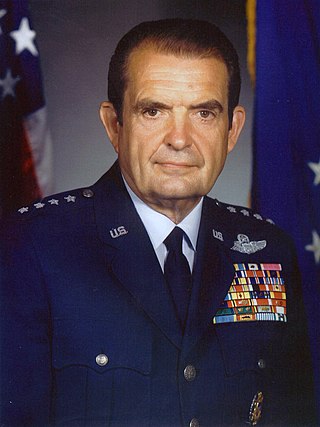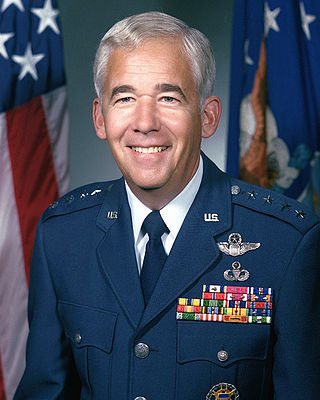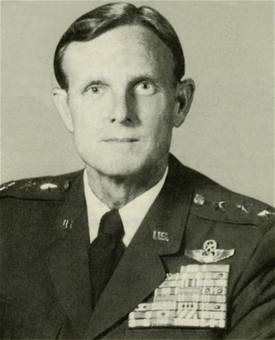
Richard Bowman Myers is a retired United States Air Force general who served as the 15th chairman of the Joint Chiefs of Staff. As chairman, Myers was the highest ranking uniformed officer of the United States military forces. He also served as the 14th president of Kansas State University from 2016 to 2022.

The United States Central Command is one of the eleven unified combatant commands of the U.S. Department of Defense. It was established in 1983, taking over the previous responsibilities of the Rapid Deployment Joint Task Force (RDJTF).

The Distinguished Flying Cross (DFC) is a military decoration of the United States Armed Forces. The medal was established on July 2, 1926, and is currently awarded to any persons who, after April 6, 1917, distinguish themselves by single acts of heroism or extraordinary achievement while participating in aerial flight. Both heroism and extraordinary achievement are entirely distinctive, involving operations that are not routine. The medal may be awarded to friendly foreign military members in ranks equivalent to the U.S. paygrade of O-6 and below in combat in support operations.

The Goldwater–Nichols Department of Defense Reorganization Act of October 4, 1986 made the most sweeping changes to the United States Department of Defense since the department was established in the National Security Act of 1947 by reworking the command structure of the U.S. military. It increased the powers of the chairman of the Joint Chiefs of Staff and implemented some of the suggestions from the Packard Commission, commissioned by President Reagan in 1985. Among other changes, Goldwater–Nichols streamlined the military chain of command, which now runs from the president through the secretary of defense directly to combatant commanders, bypassing the service chiefs. The service chiefs were assigned to an advisory role to the president and the secretary of defense, and given the responsibility for training and equipping personnel for the unified combatant commands.

Rear Admiral Benjamin Thurman Hacker (1935–2003) was a U.S. Naval officer, who became the first Naval Flight Officer (NFO) to achieve Flag rank.

David Charles Jones was a United States Air Force general and the ninth chairman of the Joint Chiefs of Staff. In this capacity, Jones served as the highest-ranking uniformed officer of the United States Armed Forces. He previously served as the ninth Chief of Staff of the United States Air Force and fifteenth commander of the United States Air Forces in Europe.

The United States Indo-Pacific Command (USINDOPACOM) is the unified combatant command of the United States Armed Forces responsible for the Indo-Pacific region.

Pope Field is a U.S. military facility located 12 miles (19 km) northwest of the central business district of Fayetteville, in Cumberland County, North Carolina, United States. Formerly known as Pope Air Force Base, the facility is now operated by the U.S. Air Force via a memorandum of agreement (MOA) and an interservices support agreement (ISSA) with the U.S. Army as part of Fort Liberty.

General Larry D. Welch is a retired United States Air Force four-star general who served as the 12th Chief of Staff of the United States Air Force. As Chief of Staff, he served as the senior uniformed Air Force officer responsible for the organization, training and equipping of a combined active duty, Guard, Reserve and civilian force serving at locations in the United States and overseas. As a member of the Joint Chiefs of Staff, he and the other service chiefs functioned as the principal military advisers to the Secretary of Defense, National Security Council and the President. He currently serves as the Chairman of the Nuclear Weapon Surety Task Force for the Defense Science Board.
The Rapid Deployment Joint Task Force (RDJTF) is an inactive United States Department of Defense Joint Task Force. It was first envisioned as a three-division force in 1979 as the Rapid Deployment Force (RDF), a highly mobile rapid deployment force that could be rapidly moved to locations outside the normal overseas deployments in Europe and Korea. Its charter was expanded and greatly strengthened in 1980 as the RDJTF. It was inactivated in 1983, and re-organized as the United States Central Command (USCENTCOM).

John Thomas Chain Jr. was a U.S. Air Force general. He was also a director of R.J. Reynolds Tobacco Company, ConAgra Foods, Inc., and Kemper Insurance Co., as well as holding other corporate offices.

Vice Admiral David Charles Nichols Jr. is a retired senior U.S. Navy officer and Naval Flight Officer. At the time of his retirement in September 2007, he was the Deputy Commander of United States Central Command (USCENTCOM) at MacDill AFB, Florida.

James Lemuel Holloway III was a United States Navy admiral and naval aviator who was decorated for his actions during World War II, the Korean War, and the Vietnam War. After the Vietnam War, he was posted to The Pentagon, where he established the Navy's Nuclear Powered Carrier Program. He served as Chief of Naval Operations from 1974 until 1978. After retiring from the Navy, Holloway served as President of the Naval Historical Foundation from 1980 to 1998 and served another ten years as its chairman until his retirement in 2008 when he became chairman emeritus. He was the author of Aircraft Carriers at War: A Personal Retrospective of Korea, Vietnam, and the Soviet Confrontation published in 2007 by the Naval Institute Press.

Lieutenant General Buster Cleveland Glosson was the deputy chief of staff for plans and operations at the headquarters of the United States Air Force (USAF) in Washington D.C. He was responsible to the secretary of the Air Force and chief of staff for the planning, operations, requirements and force structure necessary to support military operations. As the USAF operations deputy to the Joint Chiefs of Staff, he determined operational requirements, concepts, doctrine, strategy, training and the assets necessary to support national security objectives and military strategy.

Victor Eugene "Gene" Renuart Jr. is a retired United States Air Force four-star general. His last military assignment was as the commander of United States Northern Command and North American Aerospace Defense Command from March 23, 2007, to May 19, 2010. Prior to that, he served as director of strategic plans and policy, the Joint Staff. Renuart retired from the Air Force on July 1, 2010, after over 39 years of service.

William Henry Ginn Jr. was a lieutenant general in the United States Air Force.

William Evans "Bill" Gortney is a retired United States Navy admiral who served as the sixth commander of United States Northern Command and the 23rd commander of North American Aerospace Defense Command (NORAD). He previously served as the Commander, United States Fleet Forces Command from September 14, 2012 to December 2014 and Director of the Joint Staff from July 1, 2010 to August 2012. Prior to that, he served as Commander, U.S. Naval Forces Central Command/5th Fleet. He assumed his post as CDRUSNORTHCOM and commander of NORAD on December 5, 2014, and was succeeded by General Lori Robinson on May 13, 2016.

Thomas V. Draude is a retired United States Marine Brigadier General. Draude retired in 1993 after 31 years of military service. Since retirement, Draude served with USAA and the Marine Corps University Foundation. He is currently an adjunct faculty member of University of South Florida in Tampa, Florida, teaching on courses on The Vietnam War and U.S. Military War Doctrine.
Hispanics in the United States Air Force can trace their tradition of service back to the United States Army Air Forces (USAAF), the military aviation arm of the United States Army during and immediately after World War II. The USAAF was the predecessor of the United States Air Force, which was formed as a separate branch of the military on September 18, 1947, under the National Security Act of 1947. In the U.S., the term Hispanic categorizes any citizen or resident of the United States, of any racial background, of any country, and of any religion, who has at least one ancestor from the people of Spain or is of non-Hispanic origin but has an ancestor from Mexico, Puerto Rico, Cuba, Central or South America, or some other Hispanic origin. The three largest Hispanic groups in the United States are the Mexican-Americans, Puerto Ricans, and Cubans. According to the U.S. Census Bureau the estimated Hispanic population of the United States is over 50 million, or 16% of the U.S. population, and Hispanics are the nation's largest ethnic minority. The 2010 U.S. census estimate of over 50 million Hispanics in the U.S. does not include the 3.9 million residents of Puerto Rico, thereby making the people of Hispanic origin the nation's largest ethnic or race minority as of July 1, 2005.

























